Review Report: Flexible Human Behavior in BPM Environments
VerifiedAdded on 2022/11/13
|9
|2399
|53
Report
AI Summary
This report provides a comprehensive review of the research article "Specifying Flexible Human Behavior in Interaction-Intensive Process Environments" by Dorn, Dustdar, and Osterweil. The report begins with an introduction to Business Process Management (BPM) and its various methods, followed by the statement of purpose, which is to analyze the article's main findings. The report outlines the article's intention, which is to explore the role of human behavior in dynamic business environments. The research methods, including qualitative analysis and case studies using Human-centric specification Languages (hADL) and Little-JIL, are discussed. The findings highlight the use of these languages to model interaction-intensive processes and the differences between them. The report then explores the article's relevance to BPM, emphasizing the importance of understanding human behavior in process design. The comparison of ideas with other research articles is done. The conclusion summarizes the key points and the article's contribution to the field, emphasizing the importance of flexible human behavior in BPM.
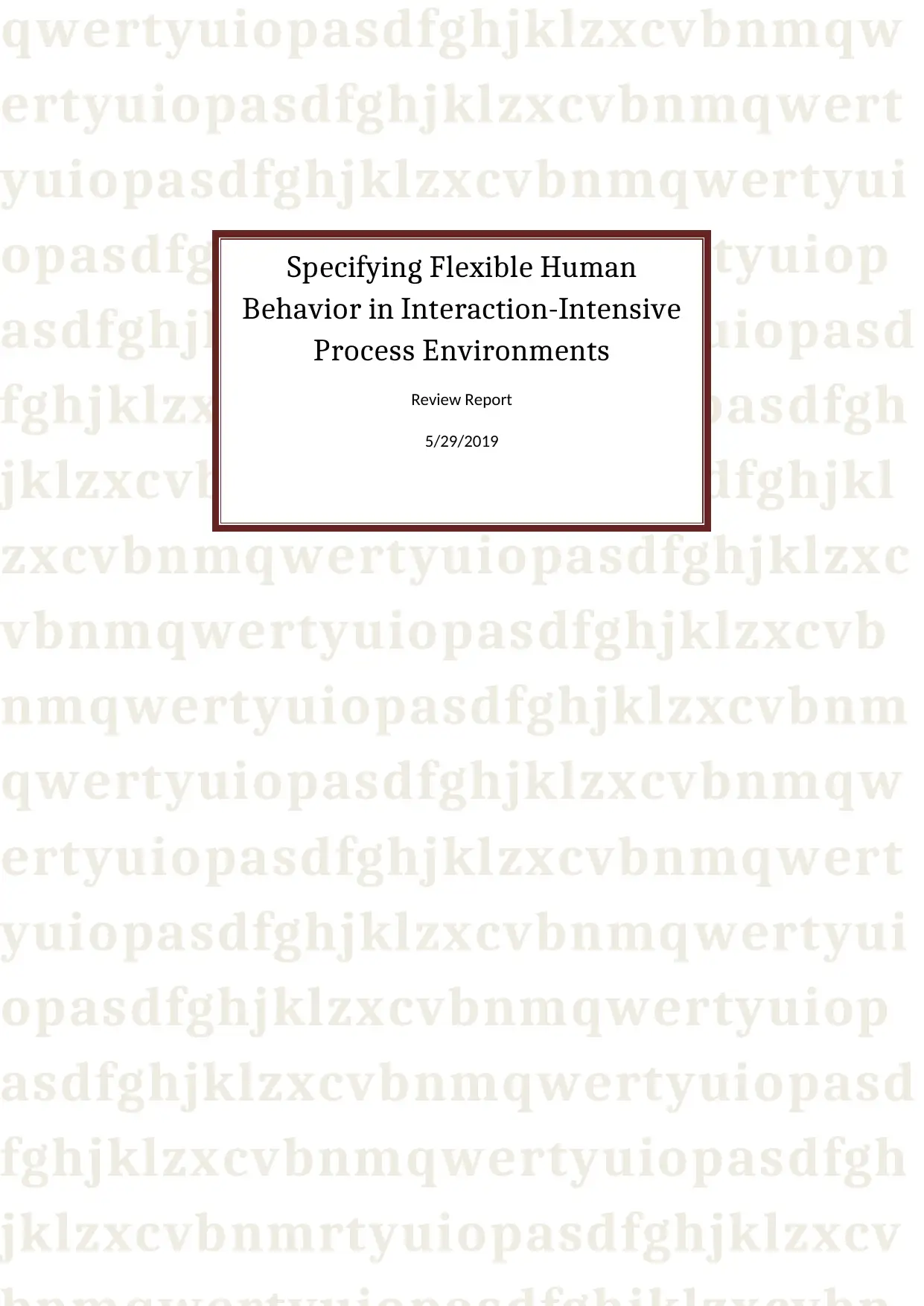
qwertyuiopasdfghjklzxcvbnmqw
ertyuiopasdfghjklzxcvbnmqwert
yuiopasdfghjklzxcvbnmqwertyui
opasdfghjklzxcvbnmqwertyuiop
asdfghjklzxcvbnmqwertyuiopasd
fghjklzxcvbnmqwertyuiopasdfgh
jklzxcvbnmqwertyuiopasdfghjkl
zxcvbnmqwertyuiopasdfghjklzxc
vbnmqwertyuiopasdfghjklzxcvb
nmqwertyuiopasdfghjklzxcvbnm
qwertyuiopasdfghjklzxcvbnmqw
ertyuiopasdfghjklzxcvbnmqwert
yuiopasdfghjklzxcvbnmqwertyui
opasdfghjklzxcvbnmqwertyuiop
asdfghjklzxcvbnmqwertyuiopasd
fghjklzxcvbnmqwertyuiopasdfgh
jklzxcvbnmrtyuiopasdfghjklzxcv
Specifying Flexible Human
Behavior in Interaction-Intensive
Process Environments
Review Report
5/29/2019
ertyuiopasdfghjklzxcvbnmqwert
yuiopasdfghjklzxcvbnmqwertyui
opasdfghjklzxcvbnmqwertyuiop
asdfghjklzxcvbnmqwertyuiopasd
fghjklzxcvbnmqwertyuiopasdfgh
jklzxcvbnmqwertyuiopasdfghjkl
zxcvbnmqwertyuiopasdfghjklzxc
vbnmqwertyuiopasdfghjklzxcvb
nmqwertyuiopasdfghjklzxcvbnm
qwertyuiopasdfghjklzxcvbnmqw
ertyuiopasdfghjklzxcvbnmqwert
yuiopasdfghjklzxcvbnmqwertyui
opasdfghjklzxcvbnmqwertyuiop
asdfghjklzxcvbnmqwertyuiopasd
fghjklzxcvbnmqwertyuiopasdfgh
jklzxcvbnmrtyuiopasdfghjklzxcv
Specifying Flexible Human
Behavior in Interaction-Intensive
Process Environments
Review Report
5/29/2019
Paraphrase This Document
Need a fresh take? Get an instant paraphrase of this document with our AI Paraphraser
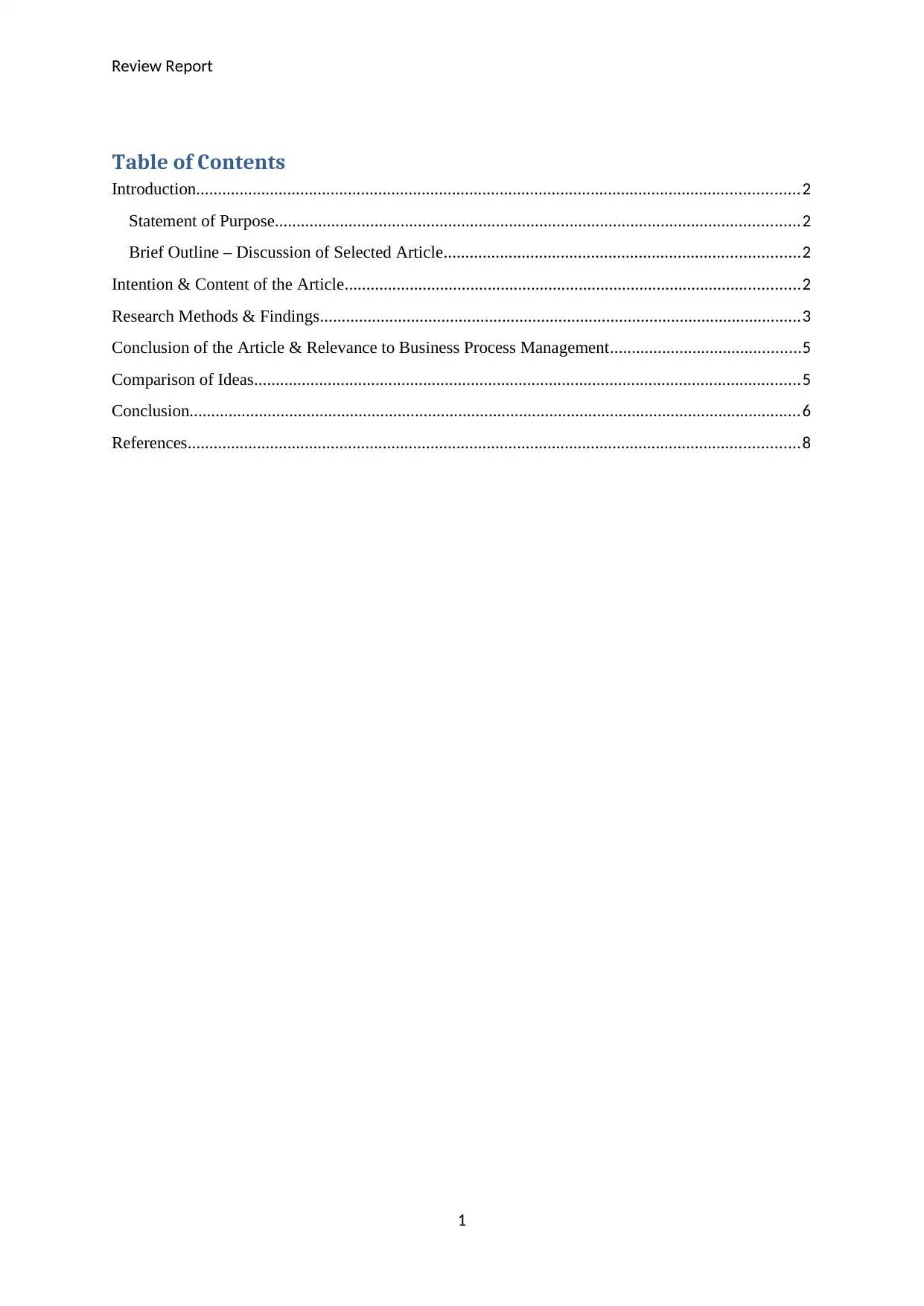
Review Report
Table of Contents
Introduction...........................................................................................................................................2
Statement of Purpose.........................................................................................................................2
Brief Outline – Discussion of Selected Article..................................................................................2
Intention & Content of the Article.........................................................................................................2
Research Methods & Findings...............................................................................................................3
Conclusion of the Article & Relevance to Business Process Management............................................5
Comparison of Ideas..............................................................................................................................5
Conclusion.............................................................................................................................................6
References.............................................................................................................................................8
1
Table of Contents
Introduction...........................................................................................................................................2
Statement of Purpose.........................................................................................................................2
Brief Outline – Discussion of Selected Article..................................................................................2
Intention & Content of the Article.........................................................................................................2
Research Methods & Findings...............................................................................................................3
Conclusion of the Article & Relevance to Business Process Management............................................5
Comparison of Ideas..............................................................................................................................5
Conclusion.............................................................................................................................................6
References.............................................................................................................................................8
1
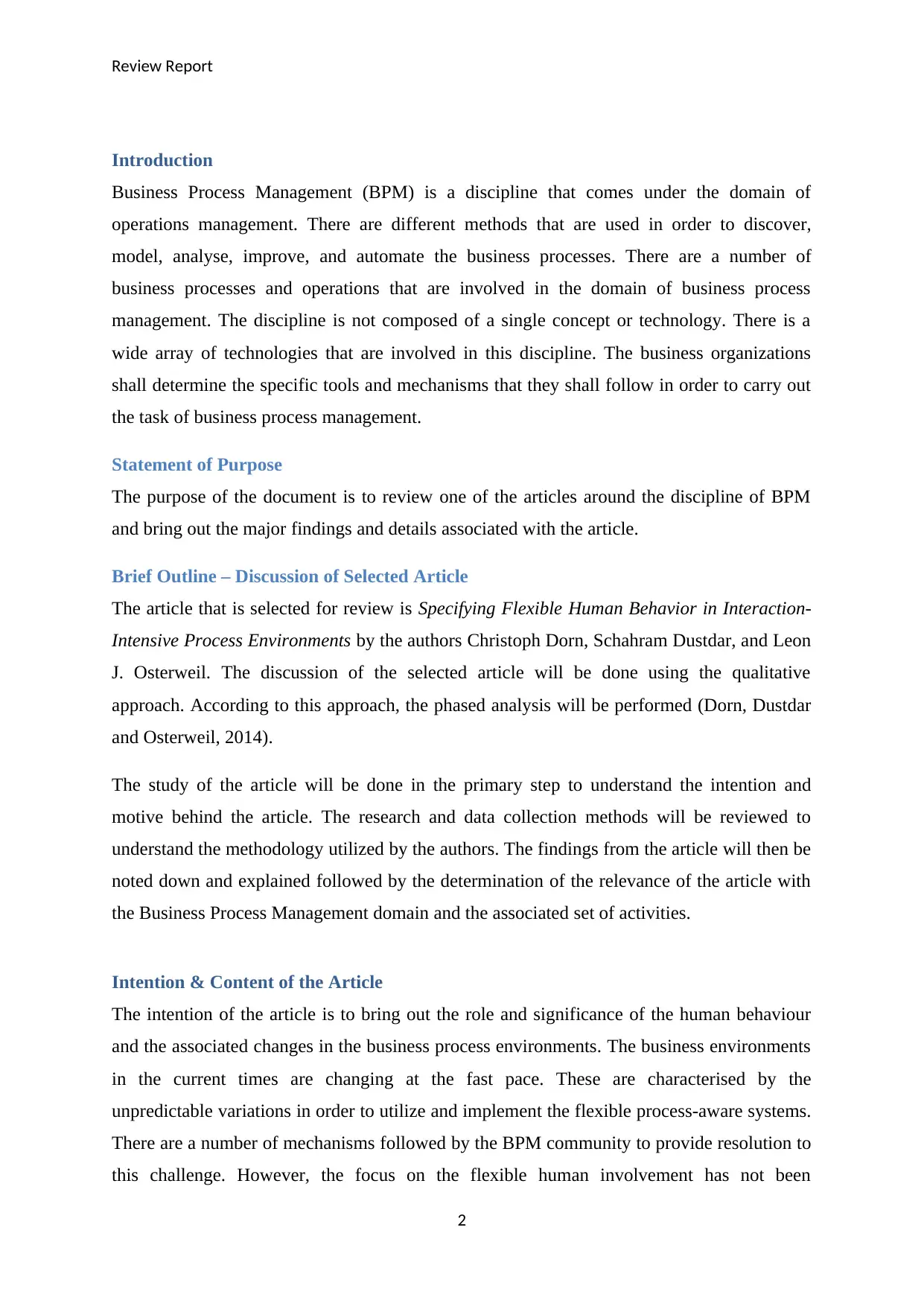
Review Report
Introduction
Business Process Management (BPM) is a discipline that comes under the domain of
operations management. There are different methods that are used in order to discover,
model, analyse, improve, and automate the business processes. There are a number of
business processes and operations that are involved in the domain of business process
management. The discipline is not composed of a single concept or technology. There is a
wide array of technologies that are involved in this discipline. The business organizations
shall determine the specific tools and mechanisms that they shall follow in order to carry out
the task of business process management.
Statement of Purpose
The purpose of the document is to review one of the articles around the discipline of BPM
and bring out the major findings and details associated with the article.
Brief Outline – Discussion of Selected Article
The article that is selected for review is Specifying Flexible Human Behavior in Interaction-
Intensive Process Environments by the authors Christoph Dorn, Schahram Dustdar, and Leon
J. Osterweil. The discussion of the selected article will be done using the qualitative
approach. According to this approach, the phased analysis will be performed (Dorn, Dustdar
and Osterweil, 2014).
The study of the article will be done in the primary step to understand the intention and
motive behind the article. The research and data collection methods will be reviewed to
understand the methodology utilized by the authors. The findings from the article will then be
noted down and explained followed by the determination of the relevance of the article with
the Business Process Management domain and the associated set of activities.
Intention & Content of the Article
The intention of the article is to bring out the role and significance of the human behaviour
and the associated changes in the business process environments. The business environments
in the current times are changing at the fast pace. These are characterised by the
unpredictable variations in order to utilize and implement the flexible process-aware systems.
There are a number of mechanisms followed by the BPM community to provide resolution to
this challenge. However, the focus on the flexible human involvement has not been
2
Introduction
Business Process Management (BPM) is a discipline that comes under the domain of
operations management. There are different methods that are used in order to discover,
model, analyse, improve, and automate the business processes. There are a number of
business processes and operations that are involved in the domain of business process
management. The discipline is not composed of a single concept or technology. There is a
wide array of technologies that are involved in this discipline. The business organizations
shall determine the specific tools and mechanisms that they shall follow in order to carry out
the task of business process management.
Statement of Purpose
The purpose of the document is to review one of the articles around the discipline of BPM
and bring out the major findings and details associated with the article.
Brief Outline – Discussion of Selected Article
The article that is selected for review is Specifying Flexible Human Behavior in Interaction-
Intensive Process Environments by the authors Christoph Dorn, Schahram Dustdar, and Leon
J. Osterweil. The discussion of the selected article will be done using the qualitative
approach. According to this approach, the phased analysis will be performed (Dorn, Dustdar
and Osterweil, 2014).
The study of the article will be done in the primary step to understand the intention and
motive behind the article. The research and data collection methods will be reviewed to
understand the methodology utilized by the authors. The findings from the article will then be
noted down and explained followed by the determination of the relevance of the article with
the Business Process Management domain and the associated set of activities.
Intention & Content of the Article
The intention of the article is to bring out the role and significance of the human behaviour
and the associated changes in the business process environments. The business environments
in the current times are changing at the fast pace. These are characterised by the
unpredictable variations in order to utilize and implement the flexible process-aware systems.
There are a number of mechanisms followed by the BPM community to provide resolution to
this challenge. However, the focus on the flexible human involvement has not been
2
⊘ This is a preview!⊘
Do you want full access?
Subscribe today to unlock all pages.

Trusted by 1+ million students worldwide
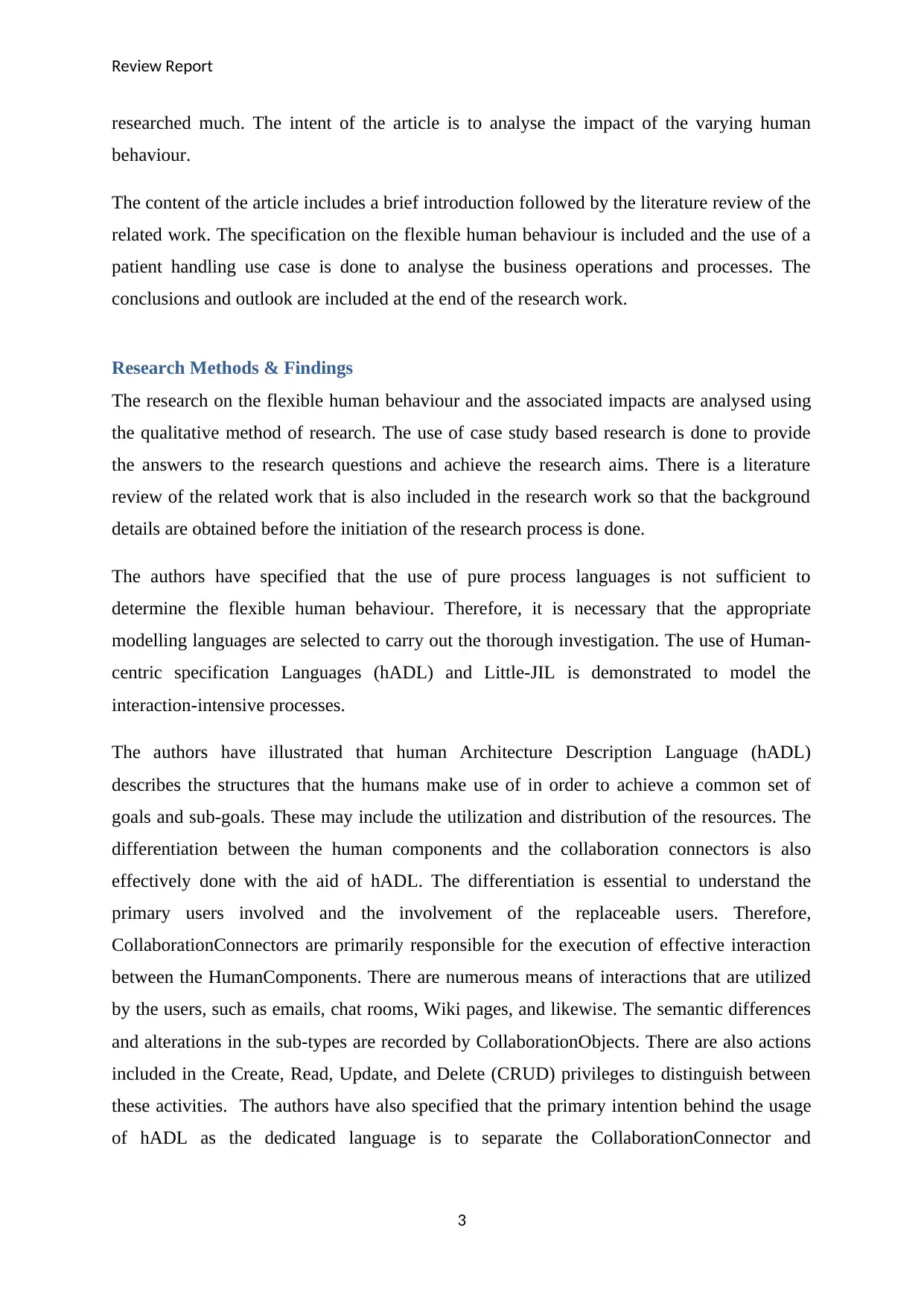
Review Report
researched much. The intent of the article is to analyse the impact of the varying human
behaviour.
The content of the article includes a brief introduction followed by the literature review of the
related work. The specification on the flexible human behaviour is included and the use of a
patient handling use case is done to analyse the business operations and processes. The
conclusions and outlook are included at the end of the research work.
Research Methods & Findings
The research on the flexible human behaviour and the associated impacts are analysed using
the qualitative method of research. The use of case study based research is done to provide
the answers to the research questions and achieve the research aims. There is a literature
review of the related work that is also included in the research work so that the background
details are obtained before the initiation of the research process is done.
The authors have specified that the use of pure process languages is not sufficient to
determine the flexible human behaviour. Therefore, it is necessary that the appropriate
modelling languages are selected to carry out the thorough investigation. The use of Human-
centric specification Languages (hADL) and Little-JIL is demonstrated to model the
interaction-intensive processes.
The authors have illustrated that human Architecture Description Language (hADL)
describes the structures that the humans make use of in order to achieve a common set of
goals and sub-goals. These may include the utilization and distribution of the resources. The
differentiation between the human components and the collaboration connectors is also
effectively done with the aid of hADL. The differentiation is essential to understand the
primary users involved and the involvement of the replaceable users. Therefore,
CollaborationConnectors are primarily responsible for the execution of effective interaction
between the HumanComponents. There are numerous means of interactions that are utilized
by the users, such as emails, chat rooms, Wiki pages, and likewise. The semantic differences
and alterations in the sub-types are recorded by CollaborationObjects. There are also actions
included in the Create, Read, Update, and Delete (CRUD) privileges to distinguish between
these activities. The authors have also specified that the primary intention behind the usage
of hADL as the dedicated language is to separate the CollaborationConnector and
3
researched much. The intent of the article is to analyse the impact of the varying human
behaviour.
The content of the article includes a brief introduction followed by the literature review of the
related work. The specification on the flexible human behaviour is included and the use of a
patient handling use case is done to analyse the business operations and processes. The
conclusions and outlook are included at the end of the research work.
Research Methods & Findings
The research on the flexible human behaviour and the associated impacts are analysed using
the qualitative method of research. The use of case study based research is done to provide
the answers to the research questions and achieve the research aims. There is a literature
review of the related work that is also included in the research work so that the background
details are obtained before the initiation of the research process is done.
The authors have specified that the use of pure process languages is not sufficient to
determine the flexible human behaviour. Therefore, it is necessary that the appropriate
modelling languages are selected to carry out the thorough investigation. The use of Human-
centric specification Languages (hADL) and Little-JIL is demonstrated to model the
interaction-intensive processes.
The authors have illustrated that human Architecture Description Language (hADL)
describes the structures that the humans make use of in order to achieve a common set of
goals and sub-goals. These may include the utilization and distribution of the resources. The
differentiation between the human components and the collaboration connectors is also
effectively done with the aid of hADL. The differentiation is essential to understand the
primary users involved and the involvement of the replaceable users. Therefore,
CollaborationConnectors are primarily responsible for the execution of effective interaction
between the HumanComponents. There are numerous means of interactions that are utilized
by the users, such as emails, chat rooms, Wiki pages, and likewise. The semantic differences
and alterations in the sub-types are recorded by CollaborationObjects. There are also actions
included in the Create, Read, Update, and Delete (CRUD) privileges to distinguish between
these activities. The authors have also specified that the primary intention behind the usage
of hADL as the dedicated language is to separate the CollaborationConnector and
3
Paraphrase This Document
Need a fresh take? Get an instant paraphrase of this document with our AI Paraphraser
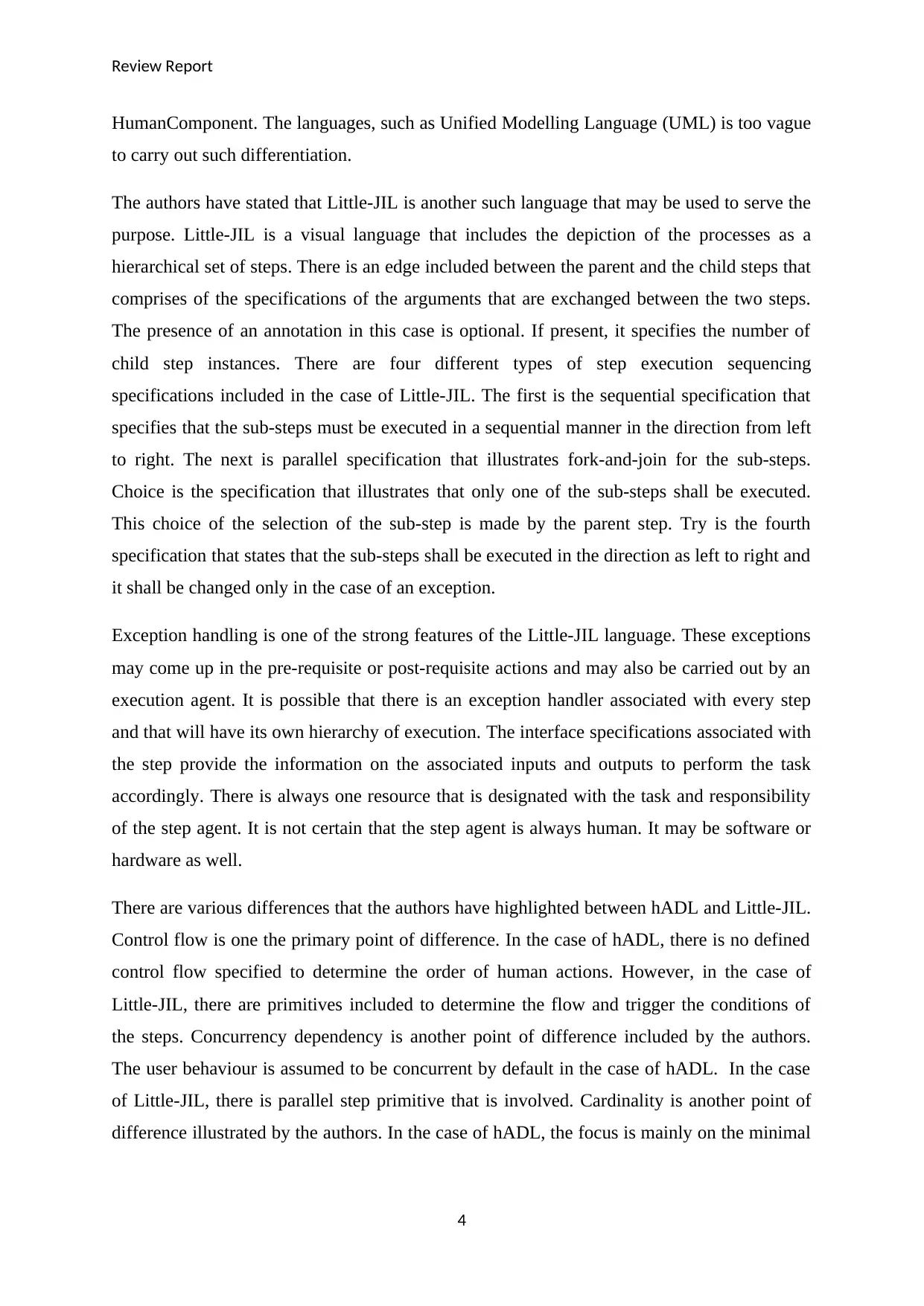
Review Report
HumanComponent. The languages, such as Unified Modelling Language (UML) is too vague
to carry out such differentiation.
The authors have stated that Little-JIL is another such language that may be used to serve the
purpose. Little-JIL is a visual language that includes the depiction of the processes as a
hierarchical set of steps. There is an edge included between the parent and the child steps that
comprises of the specifications of the arguments that are exchanged between the two steps.
The presence of an annotation in this case is optional. If present, it specifies the number of
child step instances. There are four different types of step execution sequencing
specifications included in the case of Little-JIL. The first is the sequential specification that
specifies that the sub-steps must be executed in a sequential manner in the direction from left
to right. The next is parallel specification that illustrates fork-and-join for the sub-steps.
Choice is the specification that illustrates that only one of the sub-steps shall be executed.
This choice of the selection of the sub-step is made by the parent step. Try is the fourth
specification that states that the sub-steps shall be executed in the direction as left to right and
it shall be changed only in the case of an exception.
Exception handling is one of the strong features of the Little-JIL language. These exceptions
may come up in the pre-requisite or post-requisite actions and may also be carried out by an
execution agent. It is possible that there is an exception handler associated with every step
and that will have its own hierarchy of execution. The interface specifications associated with
the step provide the information on the associated inputs and outputs to perform the task
accordingly. There is always one resource that is designated with the task and responsibility
of the step agent. It is not certain that the step agent is always human. It may be software or
hardware as well.
There are various differences that the authors have highlighted between hADL and Little-JIL.
Control flow is one the primary point of difference. In the case of hADL, there is no defined
control flow specified to determine the order of human actions. However, in the case of
Little-JIL, there are primitives included to determine the flow and trigger the conditions of
the steps. Concurrency dependency is another point of difference included by the authors.
The user behaviour is assumed to be concurrent by default in the case of hADL. In the case
of Little-JIL, there is parallel step primitive that is involved. Cardinality is another point of
difference illustrated by the authors. In the case of hADL, the focus is mainly on the minimal
4
HumanComponent. The languages, such as Unified Modelling Language (UML) is too vague
to carry out such differentiation.
The authors have stated that Little-JIL is another such language that may be used to serve the
purpose. Little-JIL is a visual language that includes the depiction of the processes as a
hierarchical set of steps. There is an edge included between the parent and the child steps that
comprises of the specifications of the arguments that are exchanged between the two steps.
The presence of an annotation in this case is optional. If present, it specifies the number of
child step instances. There are four different types of step execution sequencing
specifications included in the case of Little-JIL. The first is the sequential specification that
specifies that the sub-steps must be executed in a sequential manner in the direction from left
to right. The next is parallel specification that illustrates fork-and-join for the sub-steps.
Choice is the specification that illustrates that only one of the sub-steps shall be executed.
This choice of the selection of the sub-step is made by the parent step. Try is the fourth
specification that states that the sub-steps shall be executed in the direction as left to right and
it shall be changed only in the case of an exception.
Exception handling is one of the strong features of the Little-JIL language. These exceptions
may come up in the pre-requisite or post-requisite actions and may also be carried out by an
execution agent. It is possible that there is an exception handler associated with every step
and that will have its own hierarchy of execution. The interface specifications associated with
the step provide the information on the associated inputs and outputs to perform the task
accordingly. There is always one resource that is designated with the task and responsibility
of the step agent. It is not certain that the step agent is always human. It may be software or
hardware as well.
There are various differences that the authors have highlighted between hADL and Little-JIL.
Control flow is one the primary point of difference. In the case of hADL, there is no defined
control flow specified to determine the order of human actions. However, in the case of
Little-JIL, there are primitives included to determine the flow and trigger the conditions of
the steps. Concurrency dependency is another point of difference included by the authors.
The user behaviour is assumed to be concurrent by default in the case of hADL. In the case
of Little-JIL, there is parallel step primitive that is involved. Cardinality is another point of
difference illustrated by the authors. In the case of hADL, the focus is mainly on the minimal
4
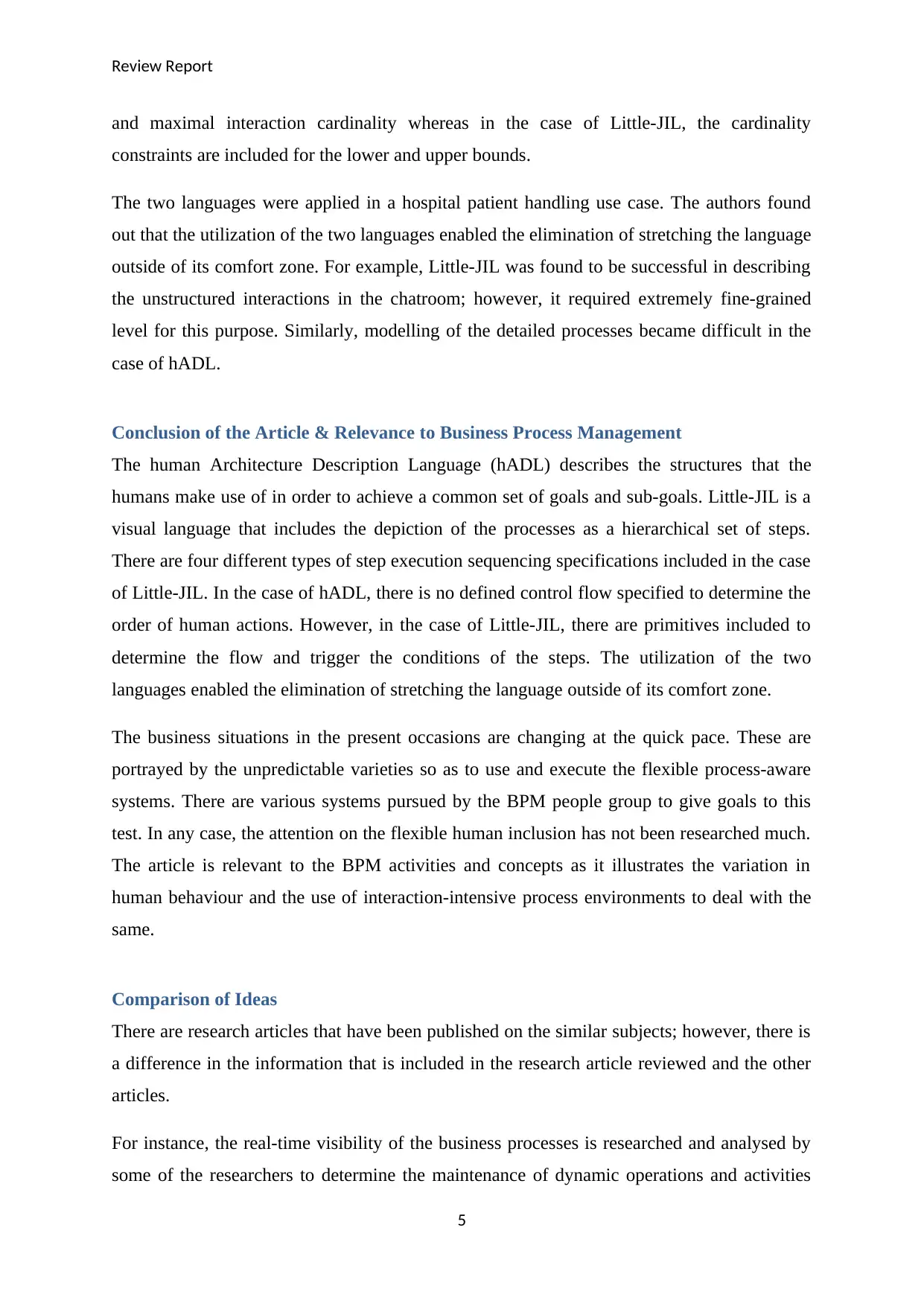
Review Report
and maximal interaction cardinality whereas in the case of Little-JIL, the cardinality
constraints are included for the lower and upper bounds.
The two languages were applied in a hospital patient handling use case. The authors found
out that the utilization of the two languages enabled the elimination of stretching the language
outside of its comfort zone. For example, Little-JIL was found to be successful in describing
the unstructured interactions in the chatroom; however, it required extremely fine-grained
level for this purpose. Similarly, modelling of the detailed processes became difficult in the
case of hADL.
Conclusion of the Article & Relevance to Business Process Management
The human Architecture Description Language (hADL) describes the structures that the
humans make use of in order to achieve a common set of goals and sub-goals. Little-JIL is a
visual language that includes the depiction of the processes as a hierarchical set of steps.
There are four different types of step execution sequencing specifications included in the case
of Little-JIL. In the case of hADL, there is no defined control flow specified to determine the
order of human actions. However, in the case of Little-JIL, there are primitives included to
determine the flow and trigger the conditions of the steps. The utilization of the two
languages enabled the elimination of stretching the language outside of its comfort zone.
The business situations in the present occasions are changing at the quick pace. These are
portrayed by the unpredictable varieties so as to use and execute the flexible process-aware
systems. There are various systems pursued by the BPM people group to give goals to this
test. In any case, the attention on the flexible human inclusion has not been researched much.
The article is relevant to the BPM activities and concepts as it illustrates the variation in
human behaviour and the use of interaction-intensive process environments to deal with the
same.
Comparison of Ideas
There are research articles that have been published on the similar subjects; however, there is
a difference in the information that is included in the research article reviewed and the other
articles.
For instance, the real-time visibility of the business processes is researched and analysed by
some of the researchers to determine the maintenance of dynamic operations and activities
5
and maximal interaction cardinality whereas in the case of Little-JIL, the cardinality
constraints are included for the lower and upper bounds.
The two languages were applied in a hospital patient handling use case. The authors found
out that the utilization of the two languages enabled the elimination of stretching the language
outside of its comfort zone. For example, Little-JIL was found to be successful in describing
the unstructured interactions in the chatroom; however, it required extremely fine-grained
level for this purpose. Similarly, modelling of the detailed processes became difficult in the
case of hADL.
Conclusion of the Article & Relevance to Business Process Management
The human Architecture Description Language (hADL) describes the structures that the
humans make use of in order to achieve a common set of goals and sub-goals. Little-JIL is a
visual language that includes the depiction of the processes as a hierarchical set of steps.
There are four different types of step execution sequencing specifications included in the case
of Little-JIL. In the case of hADL, there is no defined control flow specified to determine the
order of human actions. However, in the case of Little-JIL, there are primitives included to
determine the flow and trigger the conditions of the steps. The utilization of the two
languages enabled the elimination of stretching the language outside of its comfort zone.
The business situations in the present occasions are changing at the quick pace. These are
portrayed by the unpredictable varieties so as to use and execute the flexible process-aware
systems. There are various systems pursued by the BPM people group to give goals to this
test. In any case, the attention on the flexible human inclusion has not been researched much.
The article is relevant to the BPM activities and concepts as it illustrates the variation in
human behaviour and the use of interaction-intensive process environments to deal with the
same.
Comparison of Ideas
There are research articles that have been published on the similar subjects; however, there is
a difference in the information that is included in the research article reviewed and the other
articles.
For instance, the real-time visibility of the business processes is researched and analysed by
some of the researchers to determine the maintenance of dynamic operations and activities
5
⊘ This is a preview!⊘
Do you want full access?
Subscribe today to unlock all pages.

Trusted by 1+ million students worldwide
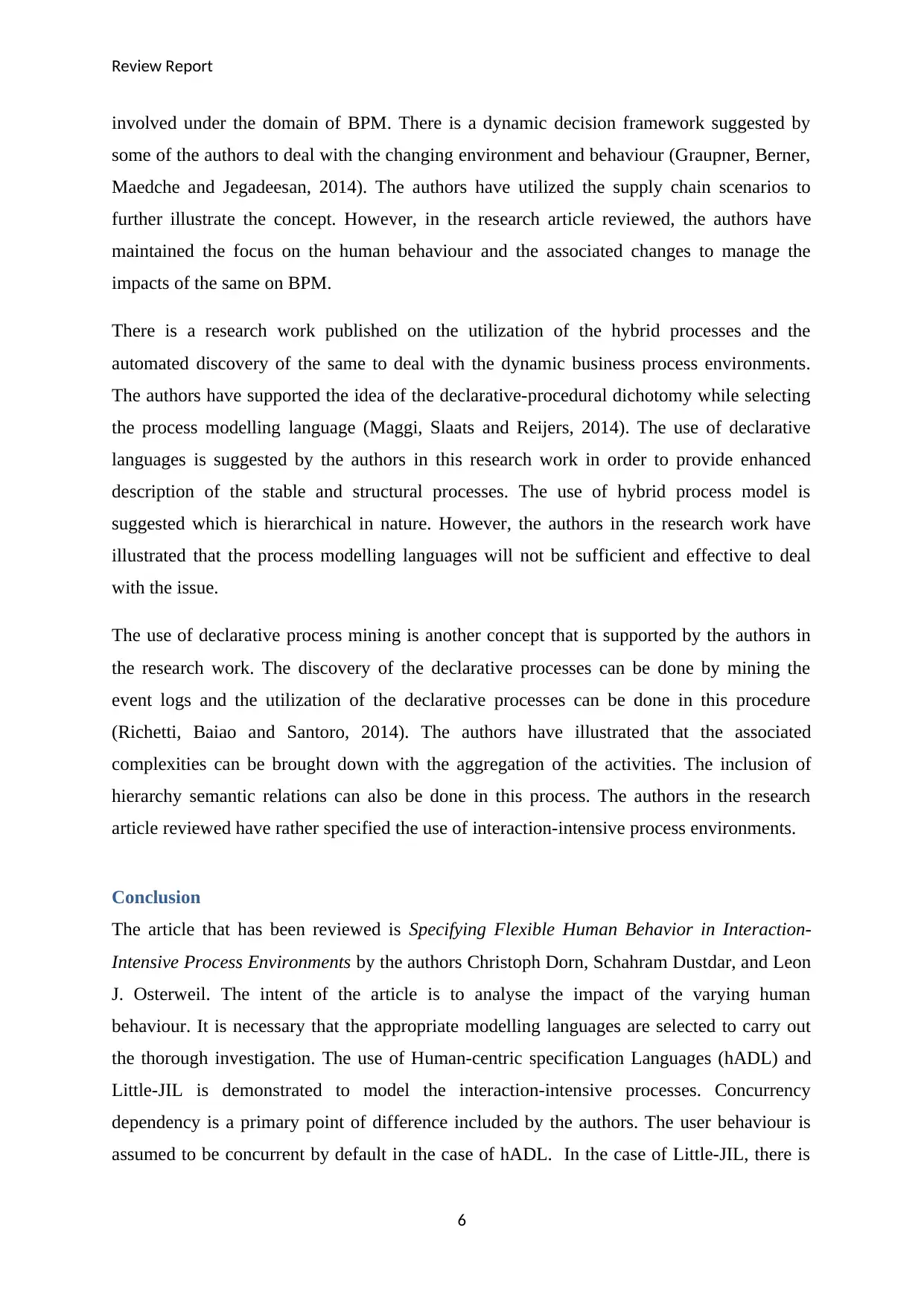
Review Report
involved under the domain of BPM. There is a dynamic decision framework suggested by
some of the authors to deal with the changing environment and behaviour (Graupner, Berner,
Maedche and Jegadeesan, 2014). The authors have utilized the supply chain scenarios to
further illustrate the concept. However, in the research article reviewed, the authors have
maintained the focus on the human behaviour and the associated changes to manage the
impacts of the same on BPM.
There is a research work published on the utilization of the hybrid processes and the
automated discovery of the same to deal with the dynamic business process environments.
The authors have supported the idea of the declarative-procedural dichotomy while selecting
the process modelling language (Maggi, Slaats and Reijers, 2014). The use of declarative
languages is suggested by the authors in this research work in order to provide enhanced
description of the stable and structural processes. The use of hybrid process model is
suggested which is hierarchical in nature. However, the authors in the research work have
illustrated that the process modelling languages will not be sufficient and effective to deal
with the issue.
The use of declarative process mining is another concept that is supported by the authors in
the research work. The discovery of the declarative processes can be done by mining the
event logs and the utilization of the declarative processes can be done in this procedure
(Richetti, Baiao and Santoro, 2014). The authors have illustrated that the associated
complexities can be brought down with the aggregation of the activities. The inclusion of
hierarchy semantic relations can also be done in this process. The authors in the research
article reviewed have rather specified the use of interaction-intensive process environments.
Conclusion
The article that has been reviewed is Specifying Flexible Human Behavior in Interaction-
Intensive Process Environments by the authors Christoph Dorn, Schahram Dustdar, and Leon
J. Osterweil. The intent of the article is to analyse the impact of the varying human
behaviour. It is necessary that the appropriate modelling languages are selected to carry out
the thorough investigation. The use of Human-centric specification Languages (hADL) and
Little-JIL is demonstrated to model the interaction-intensive processes. Concurrency
dependency is a primary point of difference included by the authors. The user behaviour is
assumed to be concurrent by default in the case of hADL. In the case of Little-JIL, there is
6
involved under the domain of BPM. There is a dynamic decision framework suggested by
some of the authors to deal with the changing environment and behaviour (Graupner, Berner,
Maedche and Jegadeesan, 2014). The authors have utilized the supply chain scenarios to
further illustrate the concept. However, in the research article reviewed, the authors have
maintained the focus on the human behaviour and the associated changes to manage the
impacts of the same on BPM.
There is a research work published on the utilization of the hybrid processes and the
automated discovery of the same to deal with the dynamic business process environments.
The authors have supported the idea of the declarative-procedural dichotomy while selecting
the process modelling language (Maggi, Slaats and Reijers, 2014). The use of declarative
languages is suggested by the authors in this research work in order to provide enhanced
description of the stable and structural processes. The use of hybrid process model is
suggested which is hierarchical in nature. However, the authors in the research work have
illustrated that the process modelling languages will not be sufficient and effective to deal
with the issue.
The use of declarative process mining is another concept that is supported by the authors in
the research work. The discovery of the declarative processes can be done by mining the
event logs and the utilization of the declarative processes can be done in this procedure
(Richetti, Baiao and Santoro, 2014). The authors have illustrated that the associated
complexities can be brought down with the aggregation of the activities. The inclusion of
hierarchy semantic relations can also be done in this process. The authors in the research
article reviewed have rather specified the use of interaction-intensive process environments.
Conclusion
The article that has been reviewed is Specifying Flexible Human Behavior in Interaction-
Intensive Process Environments by the authors Christoph Dorn, Schahram Dustdar, and Leon
J. Osterweil. The intent of the article is to analyse the impact of the varying human
behaviour. It is necessary that the appropriate modelling languages are selected to carry out
the thorough investigation. The use of Human-centric specification Languages (hADL) and
Little-JIL is demonstrated to model the interaction-intensive processes. Concurrency
dependency is a primary point of difference included by the authors. The user behaviour is
assumed to be concurrent by default in the case of hADL. In the case of Little-JIL, there is
6
Paraphrase This Document
Need a fresh take? Get an instant paraphrase of this document with our AI Paraphraser

Review Report
parallel step primitive that is involved. There are other differences in the two languages as
well. The comparison of the arguments put forward by the authors is done with the other
research articles and work published. There are different other mechanisms and processes
suggested by other authors that may be used to complete the research process.
7
parallel step primitive that is involved. There are other differences in the two languages as
well. The comparison of the arguments put forward by the authors is done with the other
research articles and work published. There are different other mechanisms and processes
suggested by other authors that may be used to complete the research process.
7
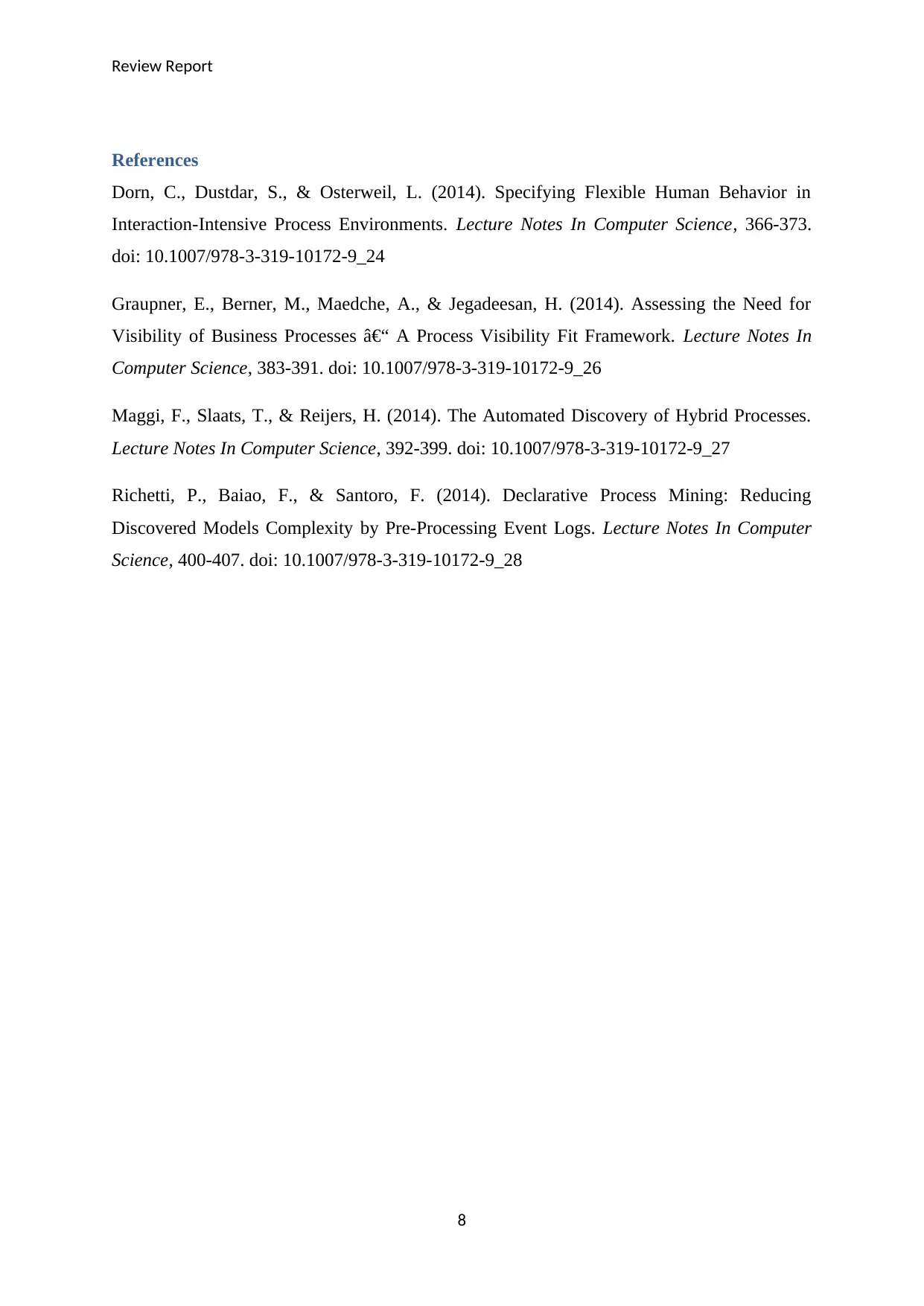
Review Report
References
Dorn, C., Dustdar, S., & Osterweil, L. (2014). Specifying Flexible Human Behavior in
Interaction-Intensive Process Environments. Lecture Notes In Computer Science, 366-373.
doi: 10.1007/978-3-319-10172-9_24
Graupner, E., Berner, M., Maedche, A., & Jegadeesan, H. (2014). Assessing the Need for
Visibility of Business Processes – A Process Visibility Fit Framework. Lecture Notes In
Computer Science, 383-391. doi: 10.1007/978-3-319-10172-9_26
Maggi, F., Slaats, T., & Reijers, H. (2014). The Automated Discovery of Hybrid Processes.
Lecture Notes In Computer Science, 392-399. doi: 10.1007/978-3-319-10172-9_27
Richetti, P., Baiao, F., & Santoro, F. (2014). Declarative Process Mining: Reducing
Discovered Models Complexity by Pre-Processing Event Logs. Lecture Notes In Computer
Science, 400-407. doi: 10.1007/978-3-319-10172-9_28
8
References
Dorn, C., Dustdar, S., & Osterweil, L. (2014). Specifying Flexible Human Behavior in
Interaction-Intensive Process Environments. Lecture Notes In Computer Science, 366-373.
doi: 10.1007/978-3-319-10172-9_24
Graupner, E., Berner, M., Maedche, A., & Jegadeesan, H. (2014). Assessing the Need for
Visibility of Business Processes – A Process Visibility Fit Framework. Lecture Notes In
Computer Science, 383-391. doi: 10.1007/978-3-319-10172-9_26
Maggi, F., Slaats, T., & Reijers, H. (2014). The Automated Discovery of Hybrid Processes.
Lecture Notes In Computer Science, 392-399. doi: 10.1007/978-3-319-10172-9_27
Richetti, P., Baiao, F., & Santoro, F. (2014). Declarative Process Mining: Reducing
Discovered Models Complexity by Pre-Processing Event Logs. Lecture Notes In Computer
Science, 400-407. doi: 10.1007/978-3-319-10172-9_28
8
⊘ This is a preview!⊘
Do you want full access?
Subscribe today to unlock all pages.

Trusted by 1+ million students worldwide
1 out of 9
Related Documents
Your All-in-One AI-Powered Toolkit for Academic Success.
+13062052269
info@desklib.com
Available 24*7 on WhatsApp / Email
![[object Object]](/_next/static/media/star-bottom.7253800d.svg)
Unlock your academic potential
Copyright © 2020–2025 A2Z Services. All Rights Reserved. Developed and managed by ZUCOL.




